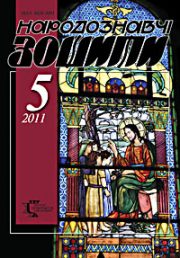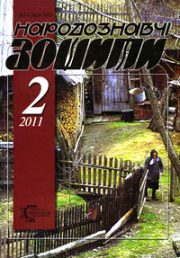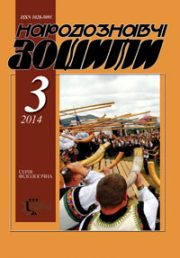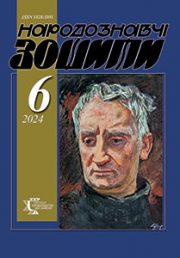2024 #2 Tymchenko T.
The Ethnology Notebooks. 2024. № 2 (176), 415—425
UDK 7.025’174
DOI https://doi.org/10.15407/nz2024.02.415
TYMCHENKO Tetiana
- ORCID ID: https://orcid.org/0000-0002-1814-4331
- Сandidate of Аrts (Ph. D), Associate Professor,
- Head of Department of Techniques & Restoration of Artworks,
- National Academy of Fine Arts and Architecture,
- 20, Voznesenskyi Uzviz Street, 04053, Kyiv, Ukraine,
- e-mail: tetiana.tymchenko@naoma.edu.ua
MYKOLAICHUK Antonina
- ORCID ID: https://orcid.org/0000-0002-3536-7262
- PhD student, Faculty of Theory & History of Art,
- National Academy of Fine Arts and Architecture,
- 20, Voznesenskyi Uzviz Street, 04053, Kyiv, Ukraine,
- e-mail: tvorcha97akyla@gmail.com
Abstract. Introduction. This article explores how modern digital technologies are transforming the analysis and comprehension of easel paintings. It emphasizes the significance and benefits of digitally processing and reproducing high-quality images. This not only disseminates knowledge about easel paintings but also facilitates their thorough examination, especially considering limited access to originals in museum collections.
Problem Statement. The article examines the role of ICT in acquiring new insights into paintings by renowned artists through the adoption of innovative techniques in technological and art historical expertise. It also explores the potential of ICT in popularizing museum artifacts and enhancing interaction with visitors.
Purpose. The aim of the article is to explore how implementing ICT tools, like machine learning algorithms and artificial intelligence automate recognition processes for styles, techniques, and characteristics, across various facets of research on easel paintings in recent decades provide rapid access to information and foster knowledge dissemination among researchers.
Methods. To achieve the stated objective, research methods such as historical, source-study, factual, and the method of systematization of obtained data and results were employed. Their outcomes deepen understanding of art history and spur the development of novel analysis and interpretation methods for easel paintings. They include the utilization of high-quality digital images for the analysis and classification of paintings using machine learning algorithms and artificial intelligence.
Results. Implementation of innovative digital technologies, including virtual reality, augmented reality, machine learning, and artificial intelligence, has significantly improved accessibility and comprehension of easel paintings.
In conclusion, this article underscores ICT’s transformative role in studying and appreciating easel paintings. By harnessing digital technologies, researchers can surmount access barriers and delve deeper into the realm of art, enriching our understanding of cultural heritage and artistic expression. The ongoing collaboration between technology and art promises continued exploration and discovery in the field of art history.
Keywords: easel painting, museum, technological and art historical expertise, information and communication technologies, neural networks, artificial intelligence, virtual reality, augmented reality.
REFERENCES
- Tymchenko, T.R. (2017). Artistic Works Expertise: Painting (History and Methodology): Educational Manual. Kyiv: National Academy of Culture and Arts Management [in Ukrainian].
- Tsytovych, V.I. (2018). Artistic Works Expertise: Painting (Methodology and Practice): Educational Manual. Kyiv: National Academy of Culture and Arts Management [in Ukrainian].
- Florea, C., & Gieseke, F. (2018). Artistic Movement Recognition by Consensus of Boosted SVM Based Experts. Journal of Visual Communication and Image Representation, 56, 220—233. Retrieved from: https://doi.org/10.1016/j.jvcir.2018.09.015
- Zhang, A. (2020). The Narration of Art on Google Arts and Culture. In: The Macksey Journal (Vol. 1, issue 1). Retrieved from: https://www.mackseyjournal.org/publications/vol1/iss1/149/
- Chamikara, M. a. P., Bertok, P., & Liu, D. (2019). An efficient and scalable privacy preserving algorithm for big data and data streams. Computers & Security, 87, 101570. Retrieved from: https://doi.org/10.1016/j.cose.2019.101570
- Baig, M.I., Shuib, L., & Yadegaridehkordi, E. (2019). Big data adoption: State of the art and research challenges. Information Processing and Management, 56 (6), 102095. Retrieved from: https://doi.org/10.1016/j.ipm.2019.102095
- Google Arts & Culture. (N. d.). Google Arts & Culture. Retrieved from: https://artsandculture.google.com/
- Pappas, M., & Pitas, I. (2000). Digital color restoration of old paintings. IEEE Transactions on Image Processing, 9 (2), 291—294. Retrieved from: https://doi.org/10.1109/83.821745
- Stanco, F., Battiato, S., & Gallo, G. (2017). Digital Imaging for Cultural Heritage Preservation. In: CRC Press eBooks. Retrieved from: https://doi.org/10.1201/b11049
- Cucci, C., Picollo, M., & Vervat, M. (2012). Trans-illumination and trans-irradiation with digital cameras: Potentials and limits of two imaging techniques used for the diagnostic investigation of paintings. Journal of Cultural Heritage, 13 (1), 83—88. Retrieved from: https://doi.org/10.1016/j.culher.2011.07.002
- Saez-Hernandez, R., Cervera, M.L., & Morales-Rubio, A. et al. (2024). Digital Image-Based Method to Identify Historical Pigments in Wall Paintings. Dyes and Pigments, 222, 111912. Retrieved from: https://doi.org/10.1016/j.dyepig.2023.111912
- Garcнa, J. a. M., Yahaghi, E., & Amir, M. (2021). Improvement of the Digital Radiographic Images of Old Paintings on Wooden Support through the Anisotropic Diffusion Method. Journal of Cultural Heritage, 49, 115—122. Retrieved from: https://doi.org/10.1016/j.culher.2021.02.008
- Gabrieli, F., Delaney, J.K., Erdmann, R.G., & et. al. Reflectance Imaging Spectroscopy (RIS) for Operation Night Watch: Challenges and Achievements of Imaging Rembrandt’s masterpiece in the glass Chamber at the Rijksmuseum. Sensors, 21 (20), 6855. Retrieved from: https://doi.org/10.3390/s21206855
- Sabetsarvestani, Z., Sober, B., Higgitt, C., & et al. (2019). Artificial intelligence for art investigation: Meeting the challenge of separating x-ray images of the Ghent Altarpiece. Science Advances, 5 (8). Retrieved from: https://doi.org/10.1126/sciadv.aaw7416
- Deligiannis, N., Mota, J.F.C., Cornelis, B., & et al. (2017). Multi-Modal Dictionary learning for image separation with application in art investigation. IEEE Transactions on Image Processing, 26 (2), 751—764. Retrieved from: https://doi.org/10.1109/tip.2016.2623484
- Del Chiaro, R., Bagdanov, A.D., & Del Bimbo, A. (2019). Webly-Supervised Zero-Shot Learning for Artwork Instance Recognition. Pattern Recognition Letters (Vol. 128, pp. 420—426). Retrieved from: https://doi.org/10.1016/j.patrec.2019.09.027
- Gatys, L.A., Ecker, A.S., & Bethge, M. (2016). Image Style Transfer Using Convolutional Neural Networks. 2016 IEEE Conference on Computer Vision and Pattern Recognition (CVPR). Retrieved from: https://doi.org/10.1109/cvpr.2016.265
- Gatys, L.A., Ecker, A., & Bethge, M. (2015). A Neural Algorithm of Artistic Style. Journal of Vision, 16 (12), 326. Retrieved from: https://doi.org/10.1167/16.12.326
- Wang, X., Oxholm, G., Zhang, D., & Wang, Y. (2017). Multimodal Transfer: A Hierarchical Deep Convolutional Neural Network for Fast Artistic Style Transfer. Proceedings of the IEEE Conference on Computer Vision and Pattern Recognition (CVPR). Retrieved from: https://doi.org/10.1109/cvpr.2017.759
- Lecoutre, A., Negrevergne, B., & Yger, F. (2017). Recognizing Art Style Automatically in Painting with Deep Learning. Proceedings of the Ninth Asian Conference on Machine Learning, PMLR 77, 327—342. Retrieved from: http://proceedings.mlr.press/v77/lecoutre17a/lecoutre17a.pdf
- Elgammal, A., Mazzone, M., Liu, B., & et al. (2018). The shape of art history in the eyes of the machine. Proceedings of the AAAI Conference on Artificial Intelligence, 32 (1). Retrieved from: https://doi.org/10.1609/aaai.v32i1.11894
- Foka, A.F. (2021). Computer Vision Applications for Art History: Reflections and Paradigms for Future Research. BCS Learning & Development. Retrieved from: https://doi.org/10.14236/ewic/eva2021.12
- He, Z., Wu, L., & Li, X. (2018). When art meets tech: The role of augmented reality in enhancing museum experiences and purchase intentions. Tourism Management, 68, 127—139. Retrieved from: https://doi.org/10.1016/j.tourman.2018.03.003
- Meinecke, C., Hall, C.M., & Janicke, S. (2022). Towards Enhancing Virtual Museums by Contextualizing Art through Interactive Visualizations. Journal on Computing and Cultural Heritage, 15 (4), 1—26. Retrieved from: https://doi.org/10.1145/3527619
- Gonzalez, V., Cotte, M., Wallez, G., & et al. (2019). Unraveling the Composition of Rembrandt’s Impasto through the Identification of Unusual Plumbonacrite by Multimodal X-ray Diffraction Analysis. Angewandte Chemie International Edition, 58 (17), 5619—5622. Retrieved from: https://doi.org/10.1002/anie.201813105
- Castelli, P.R. (n. d.). The secret of Rembrandt’s “3D” technique revealed. IBSA Foundation for scientific research. Retrieved from: https://www.ibsafoundation.org/en/blog/the-secret-of-rembrandts-3d-technique-revealed
- Moretti, P., Iwanicka, M., Melessanaki, K., & et al. (2019). Laser cleaning of paintings: in situ optimization of operative parameters through non-invasive assessment by optical coherence tomography (OCT), reflection FT-IR spectroscopy and laser induced fluorescence spectroscopy (LIF). Heritage Science, 7 (1). Retrieved from: https://doi.org/10.1186/s40494-019-0284-8
- Pospisilova, E. (Ed.). (2018). Depth-resolved analysis of historical painting model samples by means of laser-induced breakdown spectroscopy and handheld X-ray fluorescence. Spectrochimica Acta. Part B: Atomic Spectroscopy, 147, 100—108. Retrieved from: https://doi.org/10.1016/j.sab.2018.05.018
- Andrianova, O.B., Biskulova, S.O., Zhyvkova, O.V., & et. al. (2019). Science. Art. Studies. Education. Technological research of artworks from the Hanenko Museum collection. Kyiv: Feniks [in Ukrainian].
- Andrianova, O.B., Biskulova, S.O., Perevalskyi, V.Ye., & et. al. (2020). Science. Art. Studies. Education. Technological Research of European Graphics from the Collection of the Khanenki Museum. Kyiv: Feniks [in Ukrainian].
- Kajiya, E., Campos, P., Rizzutto, M.A., & et. al. (2014). Evaluation of the Veracity of One Work by the Artist Di Cavalcanti through Non-Destructive Techniques: XRF, Imaging and Brush Stroke Analysis. Radiation Physics and Chemistry, 95, 373—377. Retrieved from: https://doi.org/10.1016/j.radphyschem.2013.03.027
- Deng, Y., Tang, F., Dong, W., & et. al. (2021). Exploring the Representativity of Art Paintings. IEEE Transactions on Multimedia, 23, 2794—2805. Retrieved from: https://doi.org/10.1109/tmm.2020.3016887
- ARTICT — home. (n. d.). Retrieved from: https://art-ict.github.io/artict/home.html
- Yan, S., Huang, J., Daly, N., & et. al. (2021). When de Prony Met Leonardo: An Automatic Algorithm for Chemical Element Extraction From Macro X-Ray Fluorescence Data. IEEE Transactions on Computational Imaging, 7, 908—924. https://doi.org/10.1109/tci.2021.3102820
- Yan, S., Huang, J., Daly, N., & et. al. (2020). Revealing Hidden Drawings in Leonardo’s ‘The Virgin of the Rocks’ from Macro X-Ray Fluorescence Scanning Data through Element Line Localisation. IEEE International Conference on Acoustics, Speech and Signal Processing (ICASSP). Retrieved from: https://doi.org/10.1109/icassp40776.2020.9054460
- Bourached, A., Cann, G., Griffiths, R., & Stork, D.G. (2021). Recovery of underdrawings and ghost-paintings via style transfer by deep convolutional neural networks: A digital tool for art scholars. arXiv (Cornell University). Retrieved from: http://arxiv.org/pdf/2101.10807.pdf
- Mykolaichuk, A.R. (2024). Technological Innovations in the Study and Preservation of Cultural Heritage: Application of Virtual and Augmented Reality. «ЛјHOУ» with the Proceedings of the VI International Scientific and Practical Conference «Education and Science of Today: Intersectoral Issues and Development of Sciences» (29.03.2024; Cambridge; UK), 598—599. Retrieved from: https://archive.logos-science.com/index.php/conference-proceedings/issue/view/21[in Ukrainian].
- Sober, B., Bucklow, S., Daly, N., & et. al. (2022). Revealing and reconstructing hidden or lost features in art investigation. IEEE BITS the Information Theory Magazine (Pp. 1—16). Retrieved from: https://doi.org/10.1109/mbits.2022.3207125
- Jones, C., Duffy, C., Gibson, A., & Terras, M. (2020). Understanding multispectral imaging of cultural heritage: Determining best practice in MSI analysis of historical artefacts. Journal of Cultural Heritage, 45, 339—350. Retrieved from: https://doi.org/10.1016/j.culher.2020.03.004
- Wei, W. (2023). Innovative technology in art conservation. Retrieved from: https://doi.org/10.4324/9781003217800







